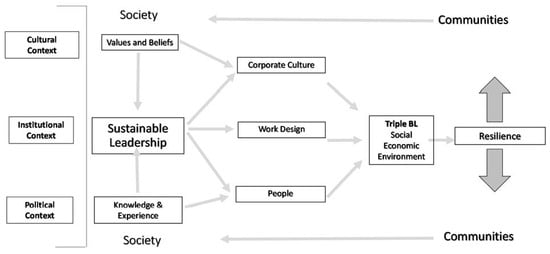Science Mapping of the Knowledge Base on Sustainable Leadership, 1990–2018
Abstract
1. Introduction
2. Conceptual Background of the Review
2.1. Conceptualizing Sustainable Leadership
- Emphasis on leadership, rather than a unitary leader.
- Long-term vision.
- Broader goals that link organizations to society.
- Ethical behavior.
- Social responsibilities of leaders and organizations.
- Innovation capacity.
- Systemic change.
- Stakeholder engagement.
- Capacity building of stakeholders.
2.2. Analytical Structure of the Knowledge Base
3. Method and Materials
3.1. Search Criteria and Identification of Sources
3.2. Data Extraction
3.3. Data Analysis
4. Results
4.1. Volume, Growth Trajectory, and Geographic Distribution of the SL Literature
4.2. Analysis of Influential Journals, Authors, and Documents
4.3. Intellectual Structure of the Sustainable Leadership Knowledge Base
4.4. Topical Foci of the Sustainable Leadership Knowledge Base
5. Discussion
5.1. Limitations
5.2. Interpretation and Implications of the Findings
6. Conclusion
Author Contributions
Acknowledgments
Conflicts of Interest
References
- Yukl, G. Effective leadership behavior: What we know and what questions need more attention. Acad. Manag. Perspect. 2012, 26, 66–85. [Google Scholar] [CrossRef]
- Bass, B.M. Two decades of research and development in transformational leadership. Eur. J. Work Organ. Psychol. 1999, 8, 9–32. [Google Scholar] [CrossRef]
- Kim, W.G.; Brymer, R.A. The effects of ethical leadership on manager job satisfaction, commitment, behavioral outcomes, and firm performance. Int. J. Hosp. Manag. 2011, 30, 1020–1026. [Google Scholar] [CrossRef]
- Hargreaves, A.; Fink, D. Sustainable Leadership; John Wiley & Sons: New York, NY, USA, 2007. [Google Scholar]
- Kantabutra, S. Putting Rhineland principles into practice in Thailand: Sustainable leadership at a bathroom design company. Glob. Bus. Organ. Excell. 2012, 31, 6–19. [Google Scholar] [CrossRef]
- Kantabutra, S. Measuring corporate sustainability: A Thai approach. Meas. Bus. Excell. 2014, 18, 73–88. [Google Scholar] [CrossRef]
- Maak, T.; Pless, N.M. Responsible leadership in a stakeholder society: A relational perspective. J. Bus. Ethics 2006, 66, 99–115. [Google Scholar] [CrossRef]
- Avery, G. Leadership for Sustainable Futures: Achieving Success in a Competitive World; Edward Elgar Publishing: Cheltenham, UK, 2005. [Google Scholar]
- Scott, W.R. Organizations and Organizing: Rational, Natural and Open Systems Perspectives; Routledge: New York, NY, USA, 2015. [Google Scholar]
- Thompson, J.D. Organizations in Action: Social Science Bases of Administrative Theory; Routledge: New York, NY, USA, 2017. [Google Scholar]
- Colbert, B.A.; Kurucz, E.C. Three conceptions of triple bottom line business sustainability and the role for HRM. People Strateg. 2007, 30, 21–29. [Google Scholar]
- Fry, L.W.; Slocum, J.W., Jr. Maximizing the triple bottom line through spiritual leadership. Organ. Dyn. 2008, 37, 86–96. [Google Scholar] [CrossRef]
- Hubbard, G. Measuring organizational performance: Beyond the triple bottom line. Bus. Strateg. Environ. 2009, 18, 177–191. [Google Scholar] [CrossRef]
- Bass, B. Leadership and Performance Beyond Expectations; Free Press: New York, NY, USA, 1985. [Google Scholar]
- Dyllick, T.; Hockerts, K. Beyond the business case for corporate sustainability. Bus. Strateg. Environ. 2002, 11, 130–141. [Google Scholar] [CrossRef]
- Marshall, J.; Coleman, G.; Reason, P. Leadership for Sustainability: An Action Research Approach; Routledge: London, UK, 2017. [Google Scholar]
- Metcalf, L.; Benn, S. Leadership for sustainability: An evolution of leadership ability. J. Bus. Ethics 2013, 112, 369–384. [Google Scholar] [CrossRef]
- Boiral, O.; Baron, C.; Gunnlaugson, O. Environmental leadership and consciousness development: A case study among Canadian SMEs. J. Bus. Ethics 2014, 123, 363–383. [Google Scholar] [CrossRef]
- Mebratu, D. Sustainability and sustainable development: Historical and conceptual review. Environ. Impact Assess. Rev. 1998, 18, 493–520. [Google Scholar] [CrossRef]
- Sachs, J.D. From millennium development goals to sustainable development goals. Lancet 2012, 379, 2206–2211. [Google Scholar] [CrossRef]
- Paraschiv, D.M.; Nemoianu, E.L.; Langă, C.A.; Szabó, T. Eco-innovation, responsible leadership and organizational change for corporate sustainability. Amfiteatru Econ. J. 2012, 14, 404–419. [Google Scholar]
- Sotarauta, M.; Horlings, I.; Liddle, J. (Eds.) Leadership and Change in Sustainable Regional Development; Routledge: London, UK, 2012. [Google Scholar]
- Visser, W.; Courtice, P. Sustainability Leadership: Linking Theory and Practice. Unpublished work. 2011. [Google Scholar]
- Avery, G.C.; Bergsteiner, H. How BMW successfully practices sustainable leadership principles. Strateg. Leadersh. 2011, 39, 11–18. [Google Scholar] [CrossRef]
- Avery, G.C.; Bergsteiner, H. Sustainable leadership practices for enhancing business resilience and performance. Strateg. Leadersh. 2011, 39, 5–15. [Google Scholar] [CrossRef]
- Day, C.; Schmidt, M. Sustaining resilience. In Developing Sustainable Leadership; Davies, B., Ed.; Paul Chapman: London, UK, 2007; pp. 65–86. [Google Scholar]
- Morsing, M.; Oswald, D. Sustainable leadership: Management control systems and organizational culture in Novo Nordisk A/S. Corp. Gov. 2009, 9, 83–99. [Google Scholar] [CrossRef]
- Ferdig, M.A. Sustainability leadership: Co-creating a sustainable future. J. Chang. Manag. 2007, 7, 25–35. [Google Scholar] [CrossRef]
- Galpin, T.; Lee Whittington, J. Sustainability leadership: From strategy to results. J. Bus. Strateg. 2012, 33, 40–48. [Google Scholar] [CrossRef]
- Lourenço, I.C.; Callen, J.L.; Branco, M.C.; Curto, J.D. The value relevance of reputation for sustainability leadership. J. Bus. Ethics 2014, 119, 17–28. [Google Scholar] [CrossRef]
- Robinson, M.; Kleffner, A.; Bertels, S. Signaling sustainability leadership: Empirical evidence of the value of DJSI membership. J. Bus. Ethics 2011, 101, 493–505. [Google Scholar] [CrossRef]
- Shriberg, M.; MacDonald, L. Sustainability leadership programs: Emerging goals, methods & best practices. J. Sustain. Educ. 2013, 5, 44–58. [Google Scholar]
- Van Eck, N.J.; Waltman, L. Citation-based clustering of publications using CitNetExplorer and VOSviewer. Scientometrics 2017, 111, 1053–1070. [Google Scholar] [CrossRef]
- Zupic, I.; Čater, T. Bibliometric methods in management and organization. Organ. Res. Methods 2015, 18, 429–472. [Google Scholar] [CrossRef]
- Nerur, S.P.; Rasheed, A.A.; Natarajan, V. The intellectual structure of the strategic management field: An author co-citation analysis. Strateg. Manag. J. 2008, 29, 319–336. [Google Scholar] [CrossRef]
- White, H.D.; McCain, K.W. Visualizing a discipline: An author co-citation analysis of information science, 1972–1995. J. Am. Soc. Inf. Sci. 1998, 49, 327–355. [Google Scholar]
- Boyack, K.; Börner, K.; Klavans, R. Mapping the structure and evolution of chemistry research. Scientometrics 2008, 79, 45–60. [Google Scholar] [CrossRef]
- Giaretta, P.; Guarino, N. Ontologies and knowledge bases towards a terminological clarification. In Towards Very Large Knowledge Bases: Knowledge Building & Knowledge Sharing; IOS Press: Amsterdam, The Netherlands, 1995; Volume 25, pp. 307–317. [Google Scholar]
- Pilkington, A.; Meredith, J. The evolution of the intellectual structure of operations management—1980–2006: A citation/co-citation analysis. J. Oper. Manag. 2009, 27, 185–202. [Google Scholar] [CrossRef]
- Price, D.J.D.S. Networks of scientific papers. Science 1965, 149, 510–515. [Google Scholar] [CrossRef]
- Albert, M. The Rhine model of capitalism: An investigation. Eur. Bus. J. 1992, 4, 8–22. [Google Scholar]
- Kantabutra, S.; Suriyankietkaew, S. Sustainable leadership in a Thai healthcare services provider. Int. J. Health Care Qual. Assur. 2011, 24, 67–80. [Google Scholar] [CrossRef]
- Kantabutra, S. Examining relationships between organic leadership and corporate sustainability: A proposed model. J. of App. Bus. Res. 2013, 28, 67–80. [Google Scholar] [CrossRef]
- Hind, P.; Wilson, A.; Lenssen, G. Developing leaders for sustainable business. Corp. Gov. 2009, 9, 7–20. [Google Scholar] [CrossRef]
- Kotter, J.P. Leading change. Harv. Bus. Rev. 2007, 85, 96–103. [Google Scholar]
- Schneider, B.; Brief, A.P.; Guzzo, R.A. Creating a climate and culture for sustainable organizational change. Organ. Dyn. 1996, 24, 7–19. [Google Scholar] [CrossRef]
- Baumgartner, R.J. Organizational culture and leadership: Preconditions for the development of a sustainable corporation. Sustain. Dev. 2009, 17, 102–113. [Google Scholar] [CrossRef]
- Hargreaves, A.; Goodson, I. Educational change over time? The sustainability and nonsustainability of three decades of secondary school change and continuity. Educ. Adm. Q. 2006, 42, 3–41. [Google Scholar] [CrossRef]
- Brown, M.E.; Treviño, L.K. Ethical leadership: A review and future directions. Leadersh. Q. 2006, 17, 595–616. [Google Scholar] [CrossRef]
- Vlachos, P.A.; Panagopoulos, N.G.; Rapp, A.A. Feeling good by doing good: Employee CSR-induced attributions, job satisfaction, and the role of charismatic leadership. J. Bus. Ethics 2013, 118, 577–588. [Google Scholar] [CrossRef]
- Avolio, B.J.; Gardner, W.L. Authentic leadership development: Getting to the root of positive forms of leadership. Leadersh. Q. 2005, 16, 315–338. [Google Scholar] [CrossRef]
- Orlitzky, M.; Siegel, D.S.; Waldman, D.A. Strategic corporate social responsibility and environmental sustainability. Bus. Soc. 2011, 50, 6–27. [Google Scholar] [CrossRef]
- Székely, F.; Knirsch, M. Responsible leadership and corporate social responsibility: Metrics for sustainable performance. Eur. Manag. J. 2005, 23, 628–647. [Google Scholar] [CrossRef]
- Pless, N.M.; Maak, T.; Stahl, G.K. Developing responsible global leaders through international service-learning programs: The Ulysses experience. Acad. Manag. Learn. Educ. 2011, 10, 237–260. [Google Scholar]
- Hay, R. The relevance of ecocentrism, personal development and transformational leadership to sustainability and identity. Sustain. Dev. 2010, 18, 163–171. [Google Scholar] [CrossRef]
- Waldman, D.A.; Siegel, D.S.; Javidan, M. Components of CEO transformational leadership and corporate social responsibility. J. Manag. Stud. 2006, 43, 1703–1725. [Google Scholar] [CrossRef]
- Kantabutra, S.; Avery, G.C. Sustainable leadership at Siam Cement Group. J. Bus. Strateg. 2011, 32, 32–41. [Google Scholar] [CrossRef]
- Kantabutra, S.; Avery, G. Sustainable leadership: Honeybee practices at a leading Asian industrial conglomerate. Asia-Pac. J. Bus. Adm. 2013, 5, 36–56. [Google Scholar] [CrossRef]
- Kantabutra, S.; Avery, G.C. Vision effects in customer and staff satisfaction: An empirical investigation. Leadersh. Organ. Dev. J. 2007, 28, 209–229. [Google Scholar] [CrossRef]
- Kantabutra, S.; Siebenhüner, T. Predicting corporate sustainability: A Thai approach. J. Appl. Bus. Res. 2011, 27, 123–133. [Google Scholar] [CrossRef]
- Avery, G.C.; Bergsteiner, H. Sustainable Leadership: Honeybee and Locust Approaches; Routledge: London, UK, 2012. [Google Scholar]
- Petrick, J.A.; Scherer, R.F.; Brodzinski, J.D.; Quinn, J.F.; Ainina, M.F. Global leadership skills and reputational capital: Intangible resources for sustainable competitive advantage. Acad. Manag. Perspect. 1999, 13, 58–69. [Google Scholar] [CrossRef]
- Piboolsravut, P. Sufficiency economy. ASEAN Econ. Bull. 2004, 21, 127–134. [Google Scholar] [CrossRef]
- Youssef, C.M.; Luthans, F. Positive organizational behavior in the workplace: The impact of hope, optimism, and resilience. J. Manag. 2007, 33, 774–800. [Google Scholar] [CrossRef]
- Lipsey, M.W.; Wilson, D.B. Practical Meta-Analysis; Sage Publications: Thousand Oaks, CA, USA, 2001. [Google Scholar]
- Kuhn, T.S. The Structure of Scientific Revolutions; University of Chicago Press: Chicago, IL, USA, 2012. [Google Scholar]
- House, R.J.; Hanges, P.J.; Javidan, M.; Dorfman, P.W.; Gupta, V. (Eds.) Culture, Leadership, and Organizations: The GLOBE Study of 62 Societies; Sage Publications: Thousand Oaks, CA, USA, 2004. [Google Scholar]
- Hallinger, P. Bringing context out of the shadows of leadership. Educ. Manag. Adm. Leadersh. 2018, 46, 5–24. [Google Scholar] [CrossRef]
- McCain, K.W. Mapping authors in intellectual space: A technical overview. J. Am. Soc. Inf. Sci. 1990, 41, 433–443. [Google Scholar] [CrossRef]
- Fahimnia, B.; Sarkis, J.; Davarzani, H. Green supply chain management: A review and bibliometric analysis. Int. J. Prod. Econ. 2015, 162, 101–114. [Google Scholar] [CrossRef]
- Mongeon, P.; Paul-Hus, A. The journal coverage of Web of Science and Scopus: A comparative analysis. Scientometrics 2016, 106, 213–228. [Google Scholar] [CrossRef]
- Falagas, M.E.; Pitsouni, E.I.; Malietzis, G.A.; Pappas, G. Comparison of PubMed, Scopus, web of science, and Google scholar: Strengths and weaknesses. FASEB J. 2008, 22, 338–342. [Google Scholar] [CrossRef]
- Moher, D.; Liberati, A.; Tetzlaff, J.; Altman, D.G. Preferred reporting items for systematic reviews and meta-analyses: The PRISMA statement. Ann. Internal Med. 2009, 151, 264–269. [Google Scholar] [CrossRef]
- Small, H. Visualizing science by citation mapping. J. Am. Soc. Inf. Sci. 1999, 50, 799–813. [Google Scholar] [CrossRef]
- Rodale, R. Sustainability: An opportunity for leadership. In Sustainable Agricultural Systems; Edwards, C., Lal, R., Madden, P., Miller, R., House, G., Eds.; St. Lucie Press: Boca Raton, FL, USA, 1990; pp. 77–86. [Google Scholar]
- Suriyankietkaew, S.; Avery, G.C. Employee satisfaction and sustainable leadership practices in Thai SMEs. J. Glob. Responsib. 2014, 5, 160–173. [Google Scholar] [CrossRef]
- Hallinger, P. Science mapping the knowledge base on educational leadership and management from the emerging regions of Asia, Africa and Latin America. Educ. Manag. Adm. Leadersh. in press.
- Hallinger, P. Science Mapping Leadership Research: A Bibliometric Analysis of The Leadership Quarterly, 1990–2018; The Center for Research on Sustainable Leadership, Mahidol University: Bangkok, Thailand, Unpublished work.
- Gladwin, T.N.; Kennelly, J.J.; Krause, T.S. Shifting paradigms for sustainable development: Implications for management theory and research. Acad. Manag. Rev. 1995, 20, 874–907. [Google Scholar] [CrossRef]
- Stern, D.I.; Common, M.S.; Barbier, E.B. Economic growth and environmental degradation: The environmental Kuznets curve and sustainable development. World Dev. 1996, 24, 1151–1160. [Google Scholar] [CrossRef]
- Thomas, T.; Schermerhorn, J.R., Jr.; Dienhart, J.W. Strategic leadership of ethical behavior in business. Acad. Manag. Perspect. 2004, 18, 56–66. [Google Scholar] [CrossRef]
- Sahlberg, P. Education policies for raising student learning: The Finnish approach. J. Educ. Policy 2007, 22, 147–171. [Google Scholar] [CrossRef]
- Smith, P.A.; Sharicz, C. The shift needed for sustainability. Learn. Organ. 2011, 18, 73–86. [Google Scholar] [CrossRef]
- Gloet, M. Knowledge management and the links to HRM: Developing leadership and management capabilities to support sustainability. Manag. Res. News 2006, 29, 402–413. [Google Scholar] [CrossRef]
- Kantabutra, S.; Suriyankietkaew, S. Sustainable leadership: Rhineland practices at a Thai small enterprise. Int. J. Entrep. Small Bus. 2013, 19, 77–94. [Google Scholar] [CrossRef]
- Griggs, D.; Stafford-Smith, M.; Gaffney, O.; Rockström, J.; Öhman, M.C.; Shyamsundar, P.; Steffen, W.; Glaser, G.; Kanie, N.; Noble, I. Policy: Sustainable development goals for people and planet. Nature 2013, 495, 305–307. [Google Scholar] [CrossRef] [PubMed]
- Fullan, M. Leadership & Sustainability: System Thinkers in Action; Corwin Press: Thousand Oaks, CA, USA, 2005. [Google Scholar]
- Hargreaves, A.; Fink, D. The seven principles of sustainable leadership. Educ. Leadersh. 2004, 61, 8–13. [Google Scholar]
- Porter, M.E.; Kramer, M.R. Strategy and society: The link between competitive advantage and corporate social responsibility. Harvard Bus. Rev. 2006, 84, 78–92. [Google Scholar]
- Quinn, l.; Dalton, M. Leading for sustainability: Implementing the tasks of leadership. Corp. Gov. 2009, 9, 21–38. [Google Scholar] [CrossRef]
- Eisenhardt, K. Building theories from case study research. Acad. Manage. Rev. 1989, 14, 532–550. [Google Scholar] [CrossRef]
- Dunphy, D. Sustainability: Seize the strategic opportunity. Exec. Excell. 2004, 21, 19–24. [Google Scholar]
- Bergsteiner, H.; Avery, G. How to kill a sustainable enterprise: A not so fictional case. Inter. J. Environ. Cultural Econ. Soc. Sustain. 2006, 2, 95–106. [Google Scholar] [CrossRef]
- Schueth, S. Socially responsible investing in the United States. J. Bus. Ethics 2003, 43, 189–194. [Google Scholar] [CrossRef]
- Gelb, D.; Strawer, J. Corporate social responsibility and financial disclosures. J. Bus. Ethics 2001, 33, 1–13. [Google Scholar] [CrossRef]
- Watt, D. Is SRI sustainable? Benefits Can. 2003, 27, 62–65. [Google Scholar]
- Boyack, K.W.; Klavans, R. Co-citation analysis, bibliographic coupling, and direct citation: Which citation approach represents the research front most accurately? J. Am. Soc. Inf. Sci. Technol. 2010, 61, 2389–2404. [Google Scholar] [CrossRef]
- Griffiths, A.; Petrick, J.A. Corporate architectures for sustainability. Int. J. Oper. Prod. Manag. 2001, 21, 1573–1585. [Google Scholar] [CrossRef]
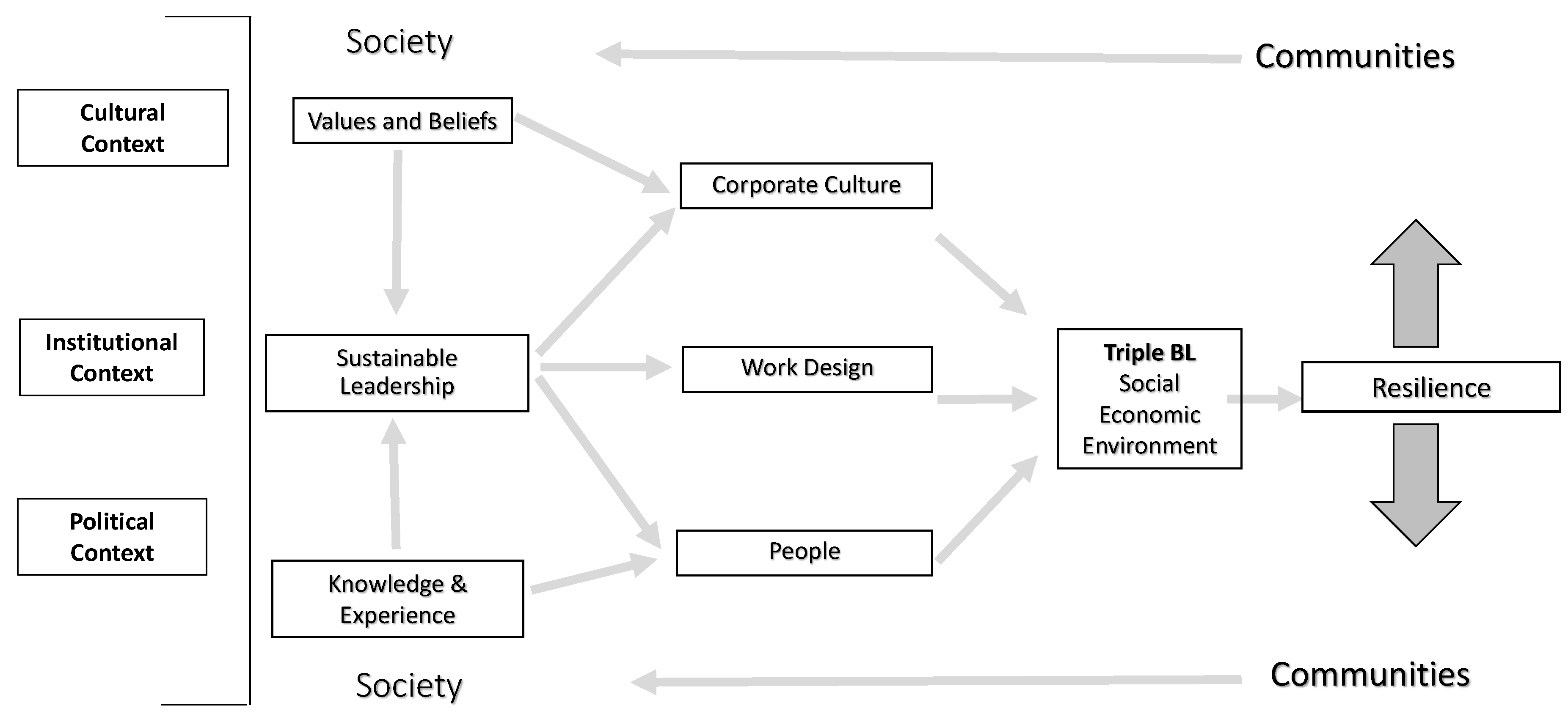
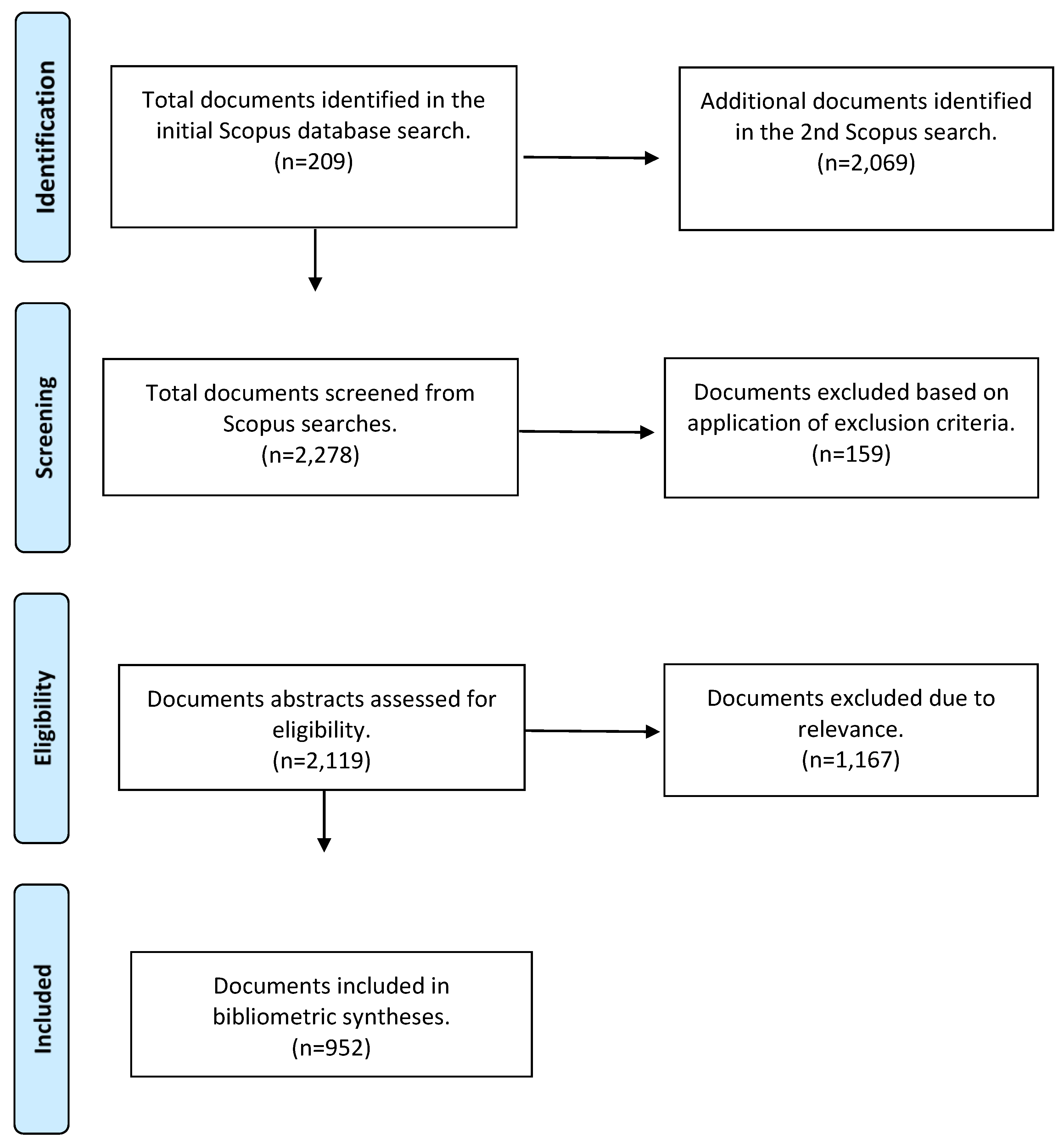
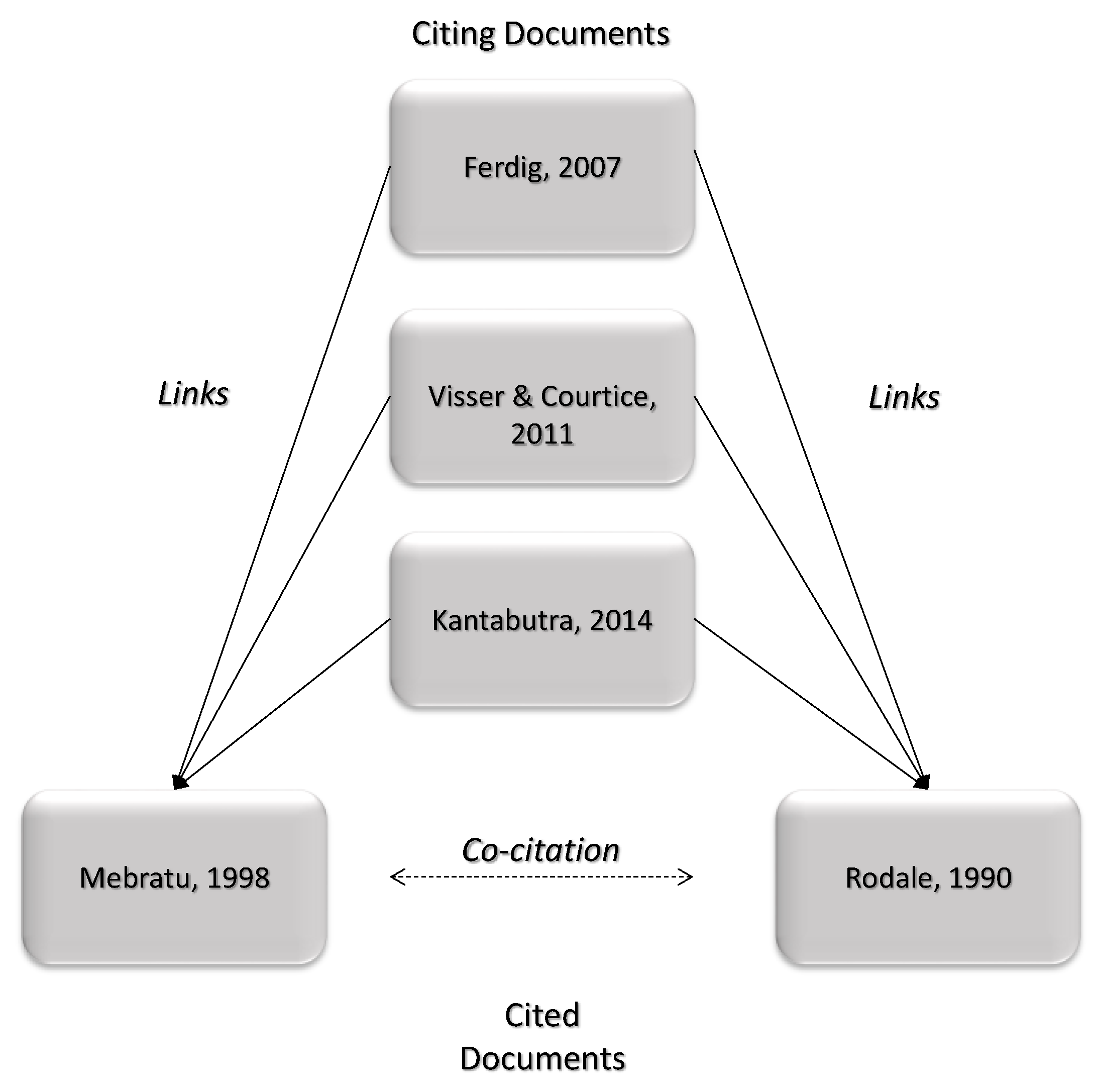
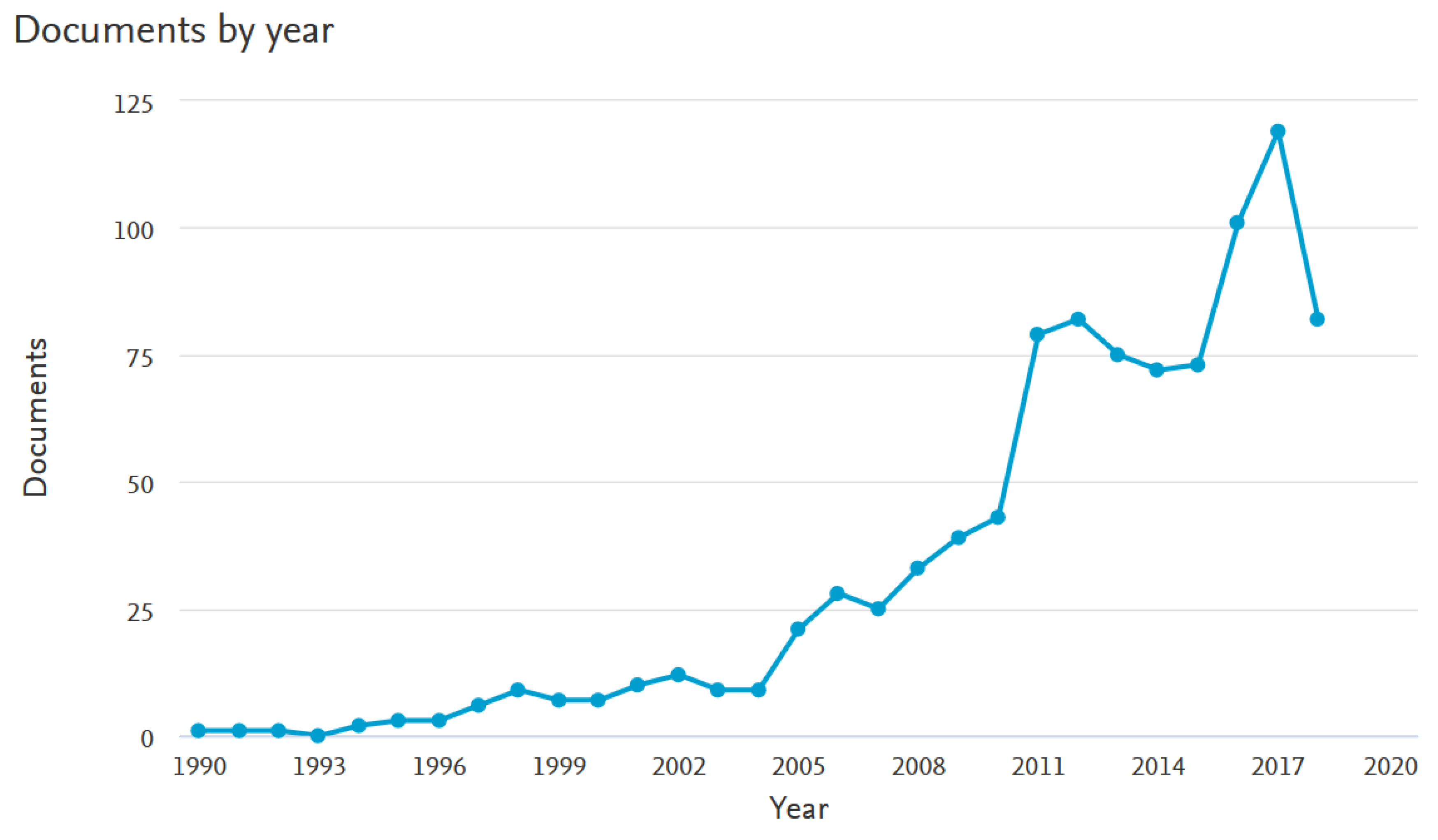

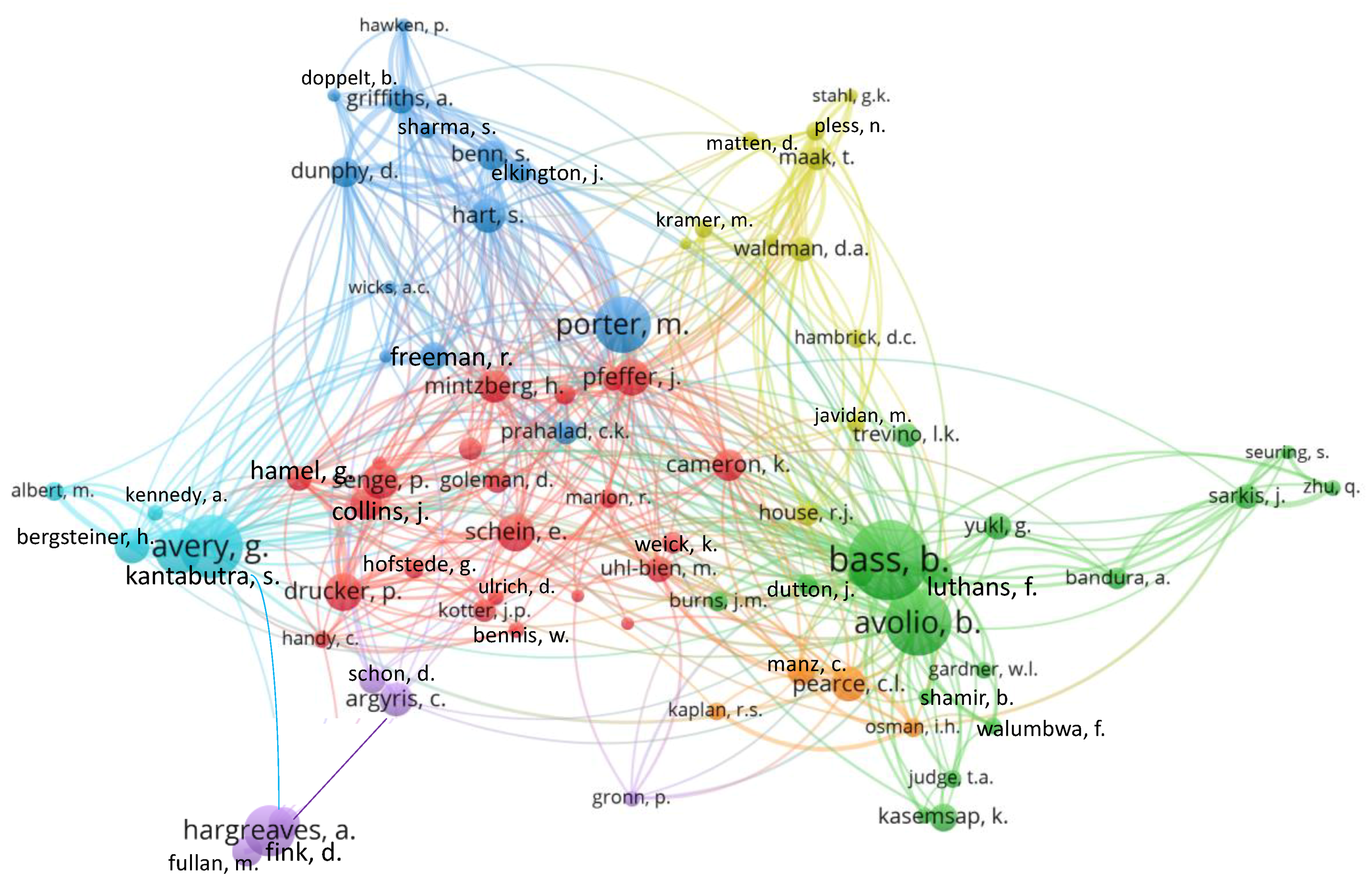
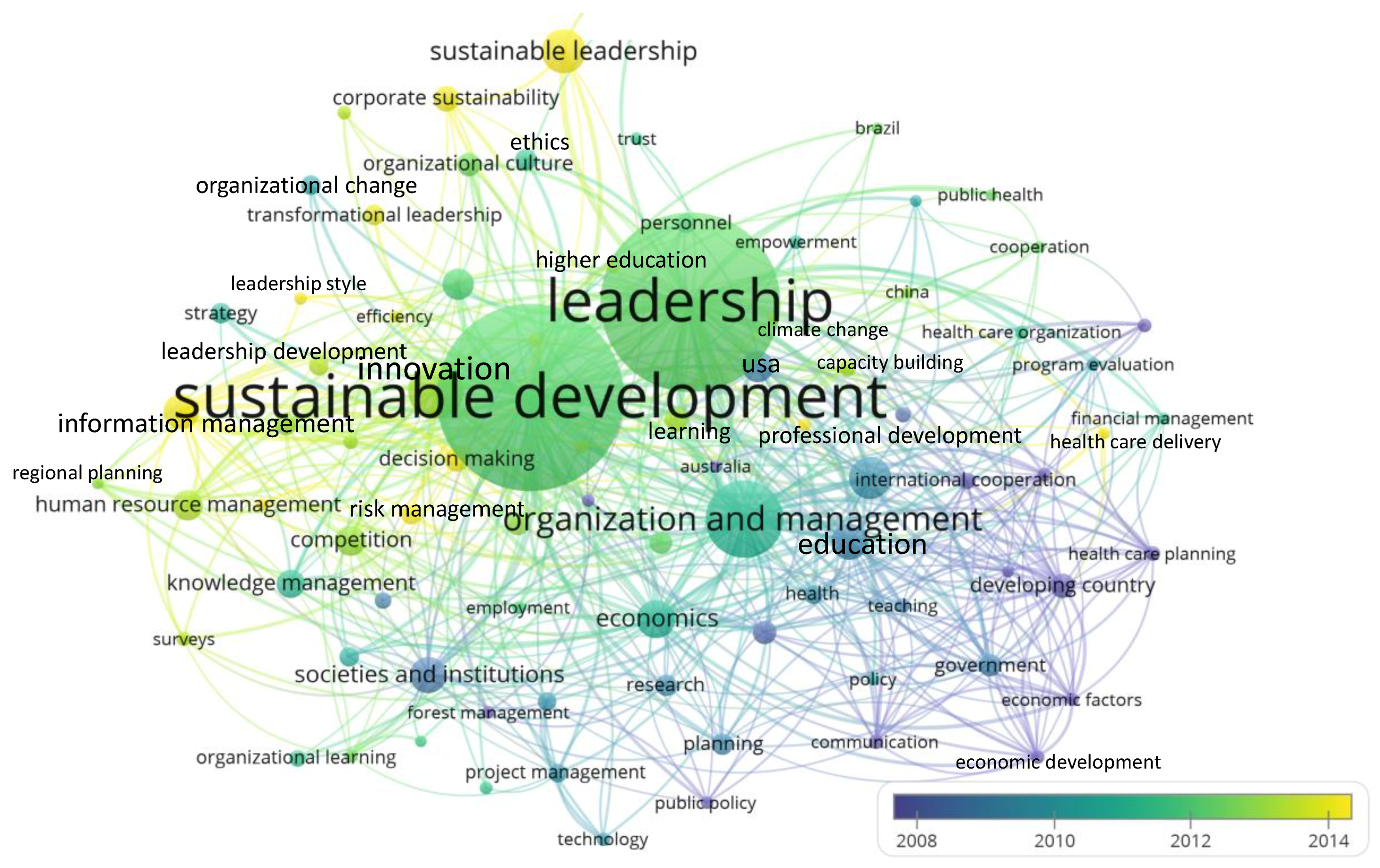
| Rank | Source | Domain | Number of Docs | Scopus Cites | Scopus Quartile | Total Link Strength |
|---|---|---|---|---|---|---|
| 1 | Journal of Bus Ethics | Bus & Man | 17 | 351 | Q1 | 7 |
| 2 | Int’l Jnl of Sust in High Ed | Education | 11 | 130 | Q1 | 2 |
| 3 | Learning Org | Education | 5 | 101 | Q2 | 3 |
| 4 | Plos One | Science | 4 | 76 | Q1 | 0 |
| 5 | Lship & Org Dev Journal | Bus & Man | 4 | 63 | Q2 | 0 |
| 6 | Journal of Bus Strat | Strat & Man | 4 | 59 | Q3 | 5 |
| 7 | Journal of Ed Admin | Education | 4 | 58 | Q1 | 0 |
| 8 | Journal of Cleaner Prod | Engineering | 4 | 50 | Q1 | 0 |
| 9 | Journal of Man Dev | Bus & Man | 6 | 48 | Q2 | 4 |
| 10 | Journal of Forestry | Forestry | 4 | 45 | Q1 | 0 |
| 11 | Ed Man Admin & Lship | Education | 4 | 40 | Q1 | 0 |
| 12 | Ind and Comm Training | Education | 14 | 38 | Q2 | 4 |
| 13 | Total Qual Man & Bus Excel | Bus & Man | 6 | 36 | Q1 | 1 |
| 14 | Journal of Org Change Man | Strat & Man | 4 | 27 | Q2 | 1 |
| 15 | Journal of Ed Change | Education | 4 | 26 | Q1 | 0 |
| 16 | Int’l Journal of Ed Man | Education | 5 | 23 | Q2 | 3 |
| 17 | Forestry Chronicle | Forestry | 4 | 18 | Q4 | 0 |
| 18 | Dev and Learning in Org | Education | 6 | 13 | Q2 | 0 |
| 19 | Global Bus and Org Excel | Bus & Man | 5 | 12 | Q3 | 6 |
| 20 | Sustainability (Switz) | NA | 5 | 12 | Q2 | 4 |
| Rank | Author | Nation | Documents | Scopus Cities | CPD | Total Link Strength |
|---|---|---|---|---|---|---|
| 1 | Hargreaves A. | USA | 6 | 325 | 54.2 | 13 |
| 2 | Benn S. | Australia | 4 | 150 | 37.5 | 4 |
| 3 | Avery G. | Australia | 7 | 135 | 16.3 | 76 |
| 4 | Kantabutra S. | Thailand | 14 | 87 | 6.2 | 64 |
| 5 | Wilson A. | UK | 2 | 87 | 6.2 | 64 |
| 6 | Metcalf L. | Australia | 3 | 78 | 26.0 | 4 |
| 7 | Lenssen G. | Belgium | 2 | 71 | 35.5 | 5 |
| 8 | Maak T. | Swiss | 4 | 56 | 14.0 | 1 |
| 9 | Pless N. | France | 4 | 56 | 14.0 | 1 |
| 10 | Davies B. | UK | 3 | 53 | 17.7 | 0 |
| 11 | Smith W. | USA | 2 | 52 | 26.0 | 0 |
| 12 | Bergsteiner H. | Australia | 2 | 51 | 25.5 | 16 |
| 13 | Campbell D. | Australia | 2 | 47 | 23.5 | 0 |
| 14 | Parkin S. | UK | 2 | 42 | 21.0 | 0 |
| 15 | Petrick J. | USA | 2 | 40 | 20.0 | 0 |
| 16 | Quinn J. | USA | 2 | 40 | 20.0 | 0 |
| 17 | Branco M. | Portugal | 2 | 38 | 19.0 | 0 |
| 18 | Allen K. | USA | 2 | 37 | 18.5 | 0 |
| 19 | Svensson G. | Norway | 3 | 36 | 12.0 | 0 |
| 20 | Bag S. | India | 4 | 35 | 8.8 | 3 |
| Rank | Document | Society | Area | SL Focus | Type of Paper | Scopus Cites |
|---|---|---|---|---|---|---|
| 1 | Hargreaves & Goodson [48] | USA/UK | Ed | Change | Emp | 178 |
| 2 | Sahlberg [82] | Finland | Ed | Change | Com | 176 |
| 3 | Thomas et al. [81] | USA | Bus | Ethics | Con | 105 |
| 4 | Hargreaves & Fink [88] | USA/Can | Ed | Integrated | Com | 95 |
| 5 | Baumgartner [47] | Austria | Bus | Change | Emp | 88 |
| 6 | Smith & Sharicz [83] | Can/USA | Bus | Change | Emp | 72 |
| 7 | Hind et al. [44] | UK/UK/Bel | Bus | Ld Dev | Emp | 66 |
| 8 | Metcalf & Benn [17] | Australia | Bus | Ethics | Con | 61 |
| 9 | Avery [8] | Australia | Bus | Integrated | Con | 59 |
| 10 | Gloet [84] | Australia | Bus | Ld Dev | Con | 54 |
| 11 | Robinson et al. [31] | Canada | Bus | Integrated | Emp | 52 |
| 12 | Hargreaves & Fink [4] | USA/Can | Ed | Integrated | Con | 44 |
| 13 | Avery & Bergsteiner [25] | Australia | Bus | Integrated | Con | 43 |
| 14 | Morsing & Oswald [27] | Den/USA | Bus | Change | Emp | 37 |
| 15 | Galpin & Lee Whittington [29] | USA | Bus | Change | Rev | 26 |
| 16 | Boiral et al. [18] | Canada | Bus | Env | Emp | 21 |
| 17 | Paraschiv et al. [21] | Hungary | Bus | Env/Change | Com | 20 |
| 18 | Kantabutra [42] | Thai | Bus | Integrated | Emp | 18 |
| 19 | Kantabutra & Siebenhüner [60] | Thai | Bus | Integrated | Emp | 16 |
| 20 | Kantabutra & Avery [57] | Thai/Aus | Bus | Integrated | Emp | 14 |
| Rank | Document | Society | Co-cites |
|---|---|---|---|
| 1 | Piboolsravut [63] | Thai | 13 |
| 2 | Albert [41] | Fra | 11 |
| 3 | Porter and Kramer [89] | USA | 11 |
| 4 | Hargreaves and Fink [88] | USA/Can | 11 |
| 5 | Quinn and Dalton [90] | USA | 10 |
| 6 | Kantabutra and Avery [57] | Thai/Aus | 9 |
| 7 | Kantabutra [42] | Thai | 9 |
| 8 | Eisenhardt [91] | USA | 9 |
| 9 | Dunphy [92] | Aus | 8 |
| 10 | Bergsteiner and Avery [93]. | Aus | 8 |
| 11 | Kantabutra and Siebenhuner [60] | Thai | 8 |
| 12 | Avery [8] | Aus | 8 |
| 13 | Bass [14] | USA | 8 |
| 14 | Schueth [94]. | USA | 7 |
| 14 | Morsing and Oswald [27] | Norway | 7 |
| 14 | Metcalf and Benn [17] | Aus | 7 |
| 17 | Gelb and Strawer [95] | USA | 6 |
| 18 | Watt [96] | Can | 6 |
| 19 | Kantabutra [5] | Thai | 6 |
| 20 | Dyllick and Hockerts [15] | Swiss/Fra | 6 |
© 2018 by the authors. Licensee MDPI, Basel, Switzerland. This article is an open access article distributed under the terms and conditions of the Creative Commons Attribution (CC BY) license (http://creativecommons.org/licenses/by/4.0/).
Share and Cite
Hallinger, P.; Suriyankietkaew, S. Science Mapping of the Knowledge Base on Sustainable Leadership, 1990–2018. Sustainability 2018, 10, 4846. https://doi.org/10.3390/su10124846
Hallinger P, Suriyankietkaew S. Science Mapping of the Knowledge Base on Sustainable Leadership, 1990–2018. Sustainability. 2018; 10(12):4846. https://doi.org/10.3390/su10124846
Chicago/Turabian StyleHallinger, Philip, and Suparak Suriyankietkaew. 2018. "Science Mapping of the Knowledge Base on Sustainable Leadership, 1990–2018" Sustainability 10, no. 12: 4846. https://doi.org/10.3390/su10124846
APA StyleHallinger, P., & Suriyankietkaew, S. (2018). Science Mapping of the Knowledge Base on Sustainable Leadership, 1990–2018. Sustainability, 10(12), 4846. https://doi.org/10.3390/su10124846





